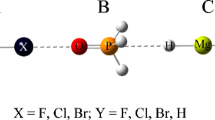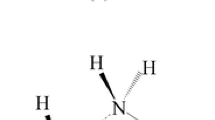Abstract
Quantum chemical calculations are performed to study the interplay between halogen⋯nitrogen and halogen⋯carbene interactions in NCX⋯NCX⋯CH2 complexes, where X = F, Cl, Br and I. Molecular geometries and interaction energies of dyads and triads are investigated at the MP2/aug-cc-pVTZ level of theory. It is found that the X⋯N and X⋯Ccarbene interaction energies in the triads are larger than those in the dyads, indicating that both the halogen bonding interactions are enhanced. The estimated values of cooperative energy E coop are all negative with much larger E coop in absolute value for the systems including iodine. The nature of halogen bond interactions of the complexes is analyzed using parameters derived from the quantum theory atoms in molecules methodology and energy decomposition analysis.

The structure of NCX⋯NCX⋯CH2 complexes (X = F, Cl, Br and I)



Similar content being viewed by others
References
Scheiner S (1997) Hydrogen bonding: A theoretical prospective. Oxford University Press, Oxford
Guardigli C, Liantonio R, Mele ML, Metrangolo P, Resnati G, Pilati T (2003) Design and synthesis of new tectons for halogen bonding-driven crystal engineering. Supramol Chem 15:177–188
Metrangolo P, Neukirch H, Pilati T, Resnati G (2005) Halogen bonding based recognition processes: A world parallel to hydrogen bonding. Acc Chem Res 38:386–395
Berka K, Laskowski R, Riley KE, Hobza P, Vondrášek J (2009) Representative amino acid side chain interactions in proteins. A comparison of highly accurate correlated ab initio quantum chemical and empirical potential procedures. J Chem Theory Comput 5:982–992
Kerdawy AE, Murray JS, Politzer P, Bleiziffer P, Heßelmann A, Görling A, Clark T (2013) Directional noncovalent interactions: Repulsion and dispersion. J Chem Theory Comput 9:2264–2275
Esrafili MD, Behzadi H, Hadipour NL (2008) Density functional theory study of N–H⋯O, O–H⋯O and C–H⋯O hydrogen-bonding effects on the 14N and 2H nuclear quadrupole coupling tensors of N-acetyl-valine. Biophys Chem 133:11–18
Esrafili MD, Behzadi H, Beheshtian J, Hadipour NL (2008) Theoretical 14N nuclear quadrupole resonance parameters for sulfa drugs: Sulfamerazine and sulfathiazole. J Mol Graph Model 27:326–331
Esrafili MD (2012) Characteristics and nature of the intermolecular interactions in boron-bonded complexes with carbene as electron donor: An ab initio, SAPT and QTAIM study. J Mol Model 18:2003–2011
Crabtree RH, Siegbahn PEM, Eisenstein O, Rheingold AL (1996) A new intermolecular interaction: Unconventional hydrogen bonds with element − hydride bonds as proton acceptor. Acc Chem Res 29:348–354
Alkorta I, Zborowski K, Elguero J, Solimannejad M (2006) Theoretical study of dihydrogen bonds between (XH)2, X = Li, Na, BeH, and MgH, and weak hydrogen bond donors (HCN, HNC, and HCCH). J Phys Chem A 110:10279–10286
Alkorta I, Elguero J, Solimannejad M, Grabowski SJ (2011) Dihydrogen bonding vs metal − σ interaction in complexes between H2 and metal hydride. J Phys Chem A 115:201–210
Y. Feng, L. Liu, J. Wang, X. Li, Q. Guo, Blue-shifted lithium bonds. Chem. Commun. (2004) 88–89.
Li Y, Wu D (2006) Do single-electron lithium bonds exist? Prediction and characterization of the H3C⋯Li–Y (Y = H, F, OH, CN, NC, and CCH) complexes. J Chem Phys 125:084317
Wang W, Zhang Y, Wang Y (2012) The π⋯π stacking interactions between homogeneous dimers of C6FxI(6–x) (x = 0, 1, 2, 3, 4, and 5): A comparative study with the halogen bond. J Phys Chem A 116:12486–12491
Grabowski SJ, Bilewicz E (2006) Cooperativity halogen bonding effect–Ab initio calculations on H2CO⋯(ClF)n complexes. Chem Phys Lett 427:51–55
Riley KE, Merz KM Jr (2007) Insights into the strength and origin of halogen bonding: The halobenzene-formaldehyde dimer. J Phys Chem A 111:1688–1694
Alkorta I, Blanco F, Elguero J (2009) A computational study of the cooperativity in clusters of interhalogen derivatives. Struct Chem 20:63–71
Parker AJ, Stewart J, Donald KJ, Parish CA (2012) Halogen bonding in DNA base pairs. J Am Chem Soc 134:5165–5172
Brinck T, Murray JS, Politzer P (1992) Surface electrostatic potentials of halogenated methanes as indicators of directional intermolecular interactions. Int J Quantum Chem Quantum Biol Symp 19:57–64
Murray JS, Paulsen K, Politzer P (1994) Molecular surface electrostatic potentials in the analysis of non-hydrogen-bonding noncovalent interactions. Proc Indiana Acad Sci 106:267–275
Auffinger P, Hays FA, Westhof E, Shing PS (2004) Halogen bonds in biological molecules. Proc Natl Acad Sci U S A 101:16789–16794
Politzer P, Lane P, Concha MC, Ma YG, Murray JS (2007) An overview of halogen bonding. J Mol Model 13:305–311
Politzer P, Murray JS, Concha MC (2008) σ-hole bonding between like atoms; a fallacy of atomic charges. J Mol Model 14:659–665
Murray JS, Lane P, Clark T, Riley KE, Politzer P (2012) σ-Holes, π-holes and electrostatically-driven interactions. J Mol Model 18:541–548
Mohajeri A, Pakiari AH, Bagheri N (2009) Theoretical studies on the nature of bonding in σ-hole complexes. Chem Phys Lett 467:393–397
Wang ZX, Zheng BS, Yu XY, Yi PG (2008) Characteristics and nature of the intermolecular interactions between thiophene and XY(X, Y = F, Cl, Br): A theoretical study. J Mol Struct (THEOCHEM) 857:13–19
Esrafili MD, Ahmadi B (2012) A theoretical investigation on the nature of Cl⋯N and Br⋯N halogen bonds in F-Ar-X⋯NCY complexes (X = Cl, Br and Y = H, F, Cl, Br, OH, NH2, CH3 and CN). Comput Theor Chem 997:77–82
Li Q, Dong X, Jing B, Li W, Cheng J, Gong B, Yua Z (2010) A new unconventional halogen bond C − X⋯H − M between HCCX (X = Cl and Br) and HMH (M = Be and Mg): An ab initio study. J Comput Chem 31:1662–1669
Alkorta I, Blanco F, Solimannejad M, Elguero J (2008) Competition of hydrogen bonds and halogen bonds in complexes of hypohalous acids with nitrogenated bases. J Phys Chem A 112:10856–10863
Riley KE, Hobza P (2008) Investigations into the nature of halogen bonding including symmetry adapted perturbation theory analyses. J Chem Theory Comput 4:232–242
Esrafili MD (2013) A theoretical investigation of the characteristics of hydrogen/halogen bonding interactions in dibromo-nitroaniline. J Mol Model 19:1417–1427
Jabłoński M, Palusiak M (2012) Nature of a hydride − halogen bond. A SAPT-, QTAIM-, and NBO-based study. J Phys Chem A 116:2322–2332
Riley KE, Murray JS, Fanfrlík J, Řezáč J, Solá RJ, Concha MC, Ramos FM, Politzer P (2013) Halogen bond tunability II: The varying roles of electrostatic and dispersion contributions to attraction in halogen bonds. J Mol Model. doi:10.1007/s00894-012-1428-x
Esrafili MD (2012) Investigation of H-bonding and halogen-bonding effects in dichloroacetic acid: DFT calculations of NQR parameters and QTAIM analysis. J Mol Model 18:5005–5016
Grabowski SJ (2012) QTAIM characteristics of halogen bond and related interactions. J Phys Chem A 116:1838–1845
Politzer P, Riley KE, Bulat FA, Murray JS (2012) Perspectives on halogen bonding and other σ-hole interactions: Lex parsimoniae (Occam’s Razor). Comput Theor Chem 998:2–8
Metrangolo P, Murray JS, Pilati T, Politzer P, Resnati G (2011) The fluorine atom as a halogen bond donor, viz. a positive site. Cryst Eng Comm 13:6593–6596
Riley KE, Murray JS, Fanfrlík J, Řezáč J, Solá RJ, Concha MC, Ramos FM, Politzer P (2011) Halogen bond tunability I: T$he effects of aromatic fluorine substitution on the strengths of halogen-bonding interactions involving chlorine, bromine, and iodine. J Mol Model 17:3309–3318
Politzer P, Murray JS, Clark T (2013) Halogen bonding and other σ-hole interactions: A perspective. Phys Chem Chem Phys 15:11178–11189
Politzer P, Murray JS (2013) Halogen bonding: An interim discussion. Chem Phys Chem 14:278–294
Awwadi FF, Willett RD, Peterson KA, Twamley B (2006) The nature of halogen⋯halogen synthons: Crystallographic and theoretical studies. Chem Eur J 12:8952–8960
Jiang Y, Alcaraz AA, Chen JM, Kobayashi H, Lu YJ, Snyder JP (2006) Diastereomers of dibromo-7-epi-10-deacetylcephalomannine: Crowded and cytotoxic taxanes exhibit halogen bonds. J Med Chem 49:1891–1899
Wang F, Ma N, Chen Q, Wang W, Wang L (2007) Halogen bonding as a new driving force for layer-by-layer assembly. Langmuir 23:9540–9542
Li Q, Yuan H, Jing B, Liu Z, Li W, Cheng J, Gong B, Sun J (2010) Theoretical study of halogen–hydride halogen bonds in F3CL⋯HM (L = Cl, Br; M = Li, BeH, MgH) complexes. Mol Phys 108:611–617
Mohajeri A, Alipour M, Mousaee M (2011) Halogen − hydride interaction between Z − X(Z = CN, NC; X = F, Cl, Br) and H − Mg − Y(Y = H, F, Cl, Br, CH3). J Phys Chem A 115:4457–4466
Li RY, Li ZR, Wu Y, Li Y, Chen W, Sun CC (2005) Study of π − halogen bonds in complexes C2H4-nFn − ClF (n = 0–2). J Phys Chem A 109:2608–2613
Wang YH, Zou JW, Lu YX, Lu QS, Xu HY (2007) Single-electron halogen bond: Ab initio study. Int J Quantum Chem 107:501–506
Esrafili MD, Mohammadirad N (2013) Insights into the strength and nature of carbene⋯halogen bond interactions: A theoretical perspective. J Mol Model 19:2559–2566
Metrangolo P, Carcenac Y, Lahtinen M, Pilati T, Rissanen K, Vij A, Resnati G (2009) Nonporous organic solids capable of dynamically resolving mixtures of diiodoperfluoroalkanes. Science 323:1461–1464
Aakeröy CB, Fasulo M, Schultheiss N, Desper J, Moore C (2007) Structural competition between hydrogen bonds and halogen bonds. J Am Chem Soc 129:13772–13773
Esrafili MD, Solimannejad M (2013) Revealing substitution effects on the strength and nature of halogen-hydride interactions: A theoretical study. J Mol Model 19:3767–3777
Zhao Q, Feng D, Hao J (2011) The cooperativity between hydrogen and halogen bond in the XY⋯HNC⋯XY (X, Y = F, Cl, Br) complexes. J Mol Model 17:2817–2823
Li QZ, Sun L, Liu XF, Li WZ, Cheng J, Zeng YL (2012) Enhancement of iodine–hydride interaction by substitution and cooperative effects in NCX–NCI–HMY complexes. Chem Phys Chem 13(2012):3997–4002
Li Q, Lin Q, Li W, Cheng J, Gong B, Sun J (2008) Cooperativity between the halogen bond and the hydrogen bond in H3N⋯XY⋯HF complexes (X, Y = F, Cl, Br). Chem Phys Chem 9:2265–2269
Schmidt MW, Baldridge KK, Boatz JA, Elbert ST, Gordon MS, Jensen JH, Koseki S, Matsunaga N, Nguyen KA, Su SJ, Windus TL, Dupuis M, Montgomery JA (1993) General atomic and molecular electronic structure system. J Comput Chem 14:1347–1363
Dunning TH (1989) Gaussian basis sets for use in correlated molecular calculations. I. The atoms boron through neon and hydrogen. J Chem Phys 90:1007–1023
Peterson KA, Figgen D, Goll E, Stoll H, Dolg M (2003) Systematically convergent basis sets with relativistic pseudopotentials. II. Small-core pseudopotentials and correlation consistent basis sets for the post-d group 16–18 elements. J Chem Phys 119:11113–11123
Boys SF, Bernardi F (1970) The calculation of small molecular interactions by the differences of separate total energies. Some procedures with reduced errors. Mol Phys 19:553–566
Su P, Li H (2009) Energy decomposition analysis of covalent bonds and intermolecular interactions. J Chem Phys 131:014102
Bulat FA, Toro-Labbe A, Brinck T, Murray JS, Politzer P (2010) Quantitative analysis of molecular surfaces: areas, volumes, electrostatic potentials and average local ionization energies. J Mol Model 16:1679–1691
Bader RFW (1990) Atoms in molecules-a quantum theory. Oxford University Press, New York
Biegler-Konig F, Schonbohm J, Bayles D (2001) AIM 2000. J Comput Chem 22:545–559
Bondi A (1964) van der Waals volumes and radii. J Phys Chem 68:441–451
Solimannejad M, Malekani M, Alkorta I (2010) Cooperative and diminutive unusual weak bonding in F3CX⋯HMgH⋯Y and F3CX⋯Y⋯HMgH trimers (X = Cl, Br; Y = HCN, and HNC). J Phys Chem A 114:12106–12111
Esrafili MD, Hadipour NL (2011) Characteristics and nature of halogen bonds in linear clusters of NCX (X = Cl, and Br): an ab initio, NBO and QTAIM study. Mol Phys 109:2451–2460
Koch U, Popelier PLA (1995) Characterization of C-H⋯O hydrogen bonds on the basis of the charge density. J Phys Chem 99:9747–9754
Hobza P, Zahradnik R, Muller-Dethlefs K (2006) The world of non-covalent interactions. Coll Czech Chem Commun 71:443–531
Author information
Authors and Affiliations
Corresponding author
Rights and permissions
About this article
Cite this article
Esrafili, M.D., Mohammdain-Sabet, F. & Esmailpour, P. Theoretical study on cooperative effects between X⋯N and X⋯Carbene halogen bonds (X = F,Cl,Br and I). J Mol Model 19, 4797–4804 (2013). https://doi.org/10.1007/s00894-013-1983-9
Received:
Accepted:
Published:
Issue Date:
DOI: https://doi.org/10.1007/s00894-013-1983-9




